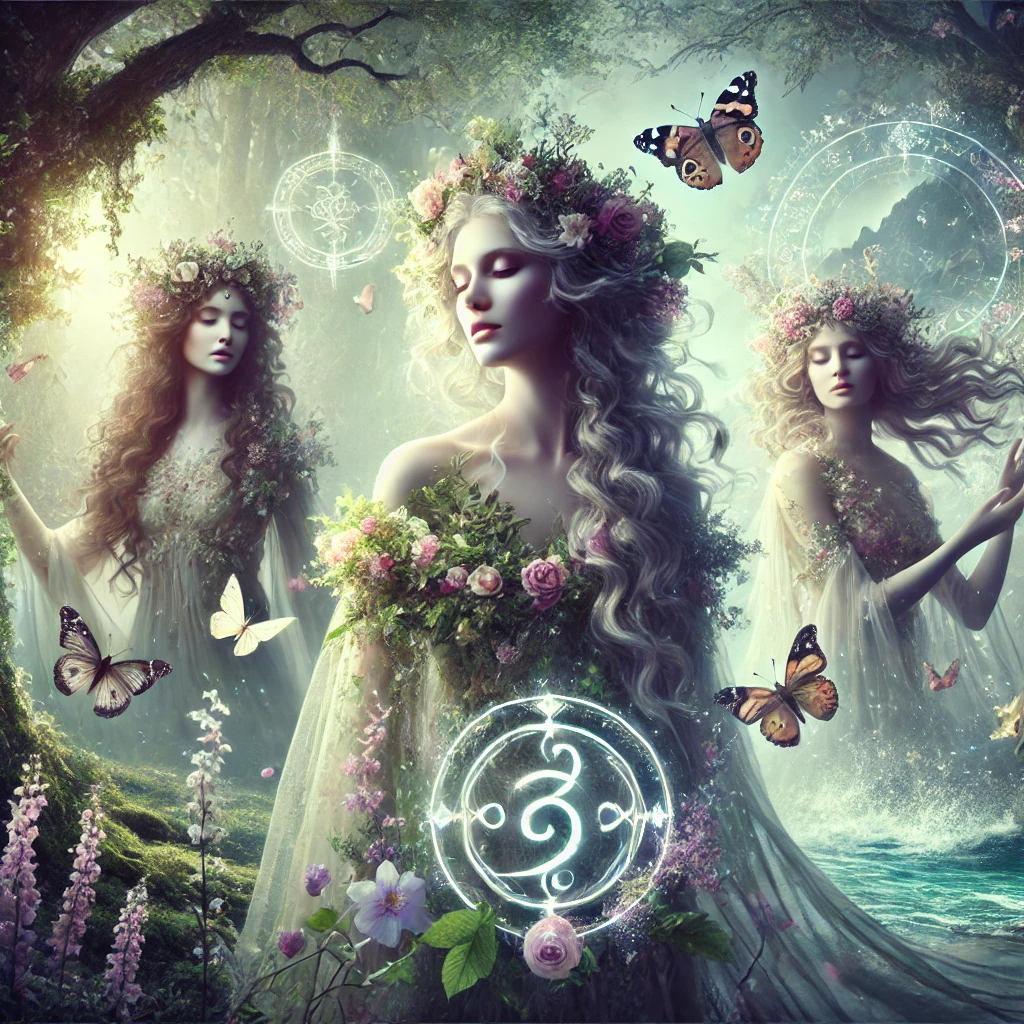Overview
Nymphs are mythological spirits of nature, often depicted in ancient lore and modern spiritual practices as embodying the vital essence of natural features such as rivers, trees, mountains, and flowers. Originating from Greek mythology, nymphs are considered minor deities or spirits who animate nature, often represented as beautiful, ethereal young women who are both nurturing and protective of their natural environments.
Roles and Functions
1. Guardians of Nature
- Environmental Protection: Nymphs are traditionally seen as protectors of their specific natural realms, whether a body of water, a woodland, or a landscape feature.
- Fertility and Growth: They promote the fertility and health of plants and animals within their domain, ensuring the natural cycles of growth and renewal are maintained.
2. Symbols of Natural Beauty and Grace
- Embodiments of Nature’s Aesthetics: Nymphs are often portrayed as personifications of the beauty and grace found in nature, inspiring artists, poets, and musicians.
- Inspirations for Creativity: Their allure and mystique have made them subjects of numerous artistic representations, symbolizing the seamless blend of beauty and nature.
3. Intermediaries Between Humans and Nature
- Spiritual Connection: Nymphs facilitate a deeper understanding and connection between humans and the natural world.
- Communication with Nature: They are believed to help humans communicate with nature, offering insights and sometimes warnings about ecological balance.
Cultural Perspectives
1. Greek Mythology
- Variety of Nymphs: Different types of nymphs include Naiads (freshwater nymphs), Dryads (tree nymphs), Nereids (sea nymphs), and Oreads (mountain nymphs), each associated with specific natural features.
- Part of the Pantheon: While not gods themselves, nymphs interact with many Olympian gods and play roles in various myths, acting as friends or consorts to deities.
2. Roman Tradition
- Continued Legacy: The Romans adopted and adapted the concept of nymphs from the Greeks, incorporating them into their own spiritual and cultural practices.
- Garden and Home Spirits: In Roman culture, nymphs were also integrated into domestic spaces, often revered in household and garden shrines.
3. Modern Paganism and Eco-spirituality
- Nature Spirits: In contemporary spiritual practices, nymphs are revered as powerful nature spirits.
- Ecological Guardianship: They are often invoked in rituals aimed at environmental protection and healing.
Engaging with Nymphs
1. Nature Walks and Meditations
- Mindful Interaction: Spending time in nature and acknowledging the presence of nymphs can foster a closer relationship with the natural world.
- Meditative Practices: Meditating in natural settings believed to be inhabited by nymphs can enhance spiritual connections and insights.
2. Environmental Conservation
- Active Stewardship: Engaging in activities that protect and restore natural habitats honors the nymphs and supports their work in nurturing the environment.
- Community Involvement: Participating in or organizing ecological activities can be seen as a modern way to collaborate with nymphs.
3. Artistic and Literary Creation
- Creative Inspiration: Nymphs continue to inspire art, literature, and music, serving as muses for works that celebrate or invoke the natural world.
- Symbolic Representation: Creating or supporting arts that highlight the role and beauty of nature can be a form of honoring nymphs.
Conclusion
Nymphs serve as timeless links between the spiritual and natural worlds, embodying the vitality and beauty of nature. They remind us of our intrinsic connection to the environment and inspire us to protect and cherish the natural world. By understanding and interacting with nymphs, whether through mythology, spiritual practice, or ecological action, we nurture our relationship with nature and contribute to the sustainability of our planet.

